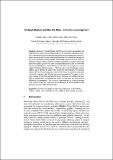Virtual Worlds and the 3D Web – time for convergence?
Abstract
Multi-User Virtual Worlds (MUVW) such as Open Wonderland and OpenSim have proved to be fruitful platforms for innovative educational practice, supporting exploratory learning and generating true engagement. However, when compared with the way educational activities have flourished through the use of the constantly evolving WWW, MUVW learning environments remain a relatively obscure niche. Since the advent and promise of Second Life more than twelve years ago there has been no critical mass reached and no movement towards standardisation. Concomitantly, the 3D Web has emerged as a recognisable if loosely defined concept. With the advent of technologies such as WebGL and a plethora of plug-in 3D viewers for web browsers, the question arises: will MUVWs converge with the 3D Web? If so, can existing educational content be migrated to the 3D Web for mass dissemination? The paper contributes a survey of 3D Web and MUVW terms, concepts, technologies and projects, illustrating their similarities, their value for education and discusses the likelihood of convergence. The survey is complemented by a cultural heritage case study of Unity 3D support for the deployment of virtual worlds in web browsers using two different approaches.
Citation
Bakri , H , Allison , C , Miller , A H D & Oliver , I A 2016 , Virtual Worlds and the 3D Web – time for convergence? in C A , L Morgado , J Pirker , D Beck , J Richter & C Guetl (eds) , Immersive Learning Research Network : Second International Conference, iLRN 2016, Santa Barbara, CA, USA, June 27 - July 1, 2016, Proceedings . Communications in Computer and Information Science , vol. 621 , Springer , pp. 29-42 , iLRN 2016 Conference , Santa Barbara , California , United States , 27/06/16 . https://doi.org/10.1007/978-3-319-41769-1_3 conference
Publication
Immersive Learning Research Network
ISSN
1865-0929Type
Conference item
Rights
© 2016, Springer. This work is made available online in accordance with the publisher’s policies. This is the author created, accepted version manuscript following peer review and may differ slightly from the final published version. The final published version of this work is available at link.springer.com / https://dx.doi.org/10.1007/978-3-319-41769-1_3
Collections
Items in the St Andrews Research Repository are protected by copyright, with all rights reserved, unless otherwise indicated.
Related items
Showing items related by title, author, creator and subject.
-
Studying programmer behaviour at scale : a case study using Amazon Mechanical Turk
Jacques, Jason T.; Kristensson, Per Ola (ACM, 2021-03-22) - Conference itemDeveloping and maintaining a correct and consistent model of how code will be executed is an ongoing challenge for software developers. However, validating the tools and techniques we develop to aid programmers can be a ... -
Investigating the accessibility of crowdwork tasks on Mechanical Turk
Uzor, Stephen; Jacques, Jason T.; Dudley, John J.; Kristensson, Per Ola (ACM, 2021-05-06) - Conference itemCrowdwork can enable invaluable opportunities for people with disabilities, not least the work fexibility and the ability to work from home, especially during the current Covid-19 pandemic. This paper investigates how ... -
Crowdsourcing design guidance for contextual adaptation of text content in augmented reality
Dudley, John J.; Jacques, Jason T.; Kristensson, Per Ola (ACM, 2021-05-06) - Conference itemAugmented Reality (AR) can deliver engaging user experiences that seamlessly meld virtual content with the physical environment. However, building such experiences is challenging due to the developer's inability to assess ...

